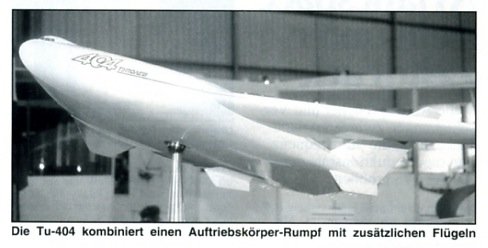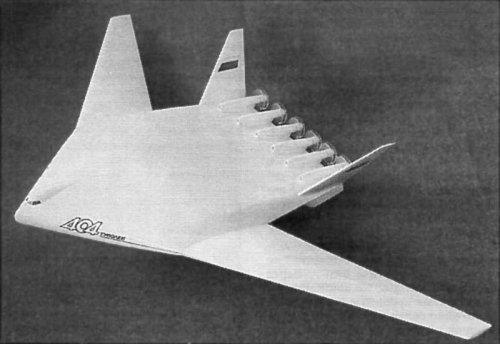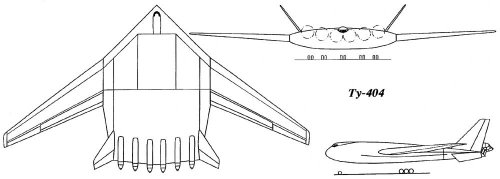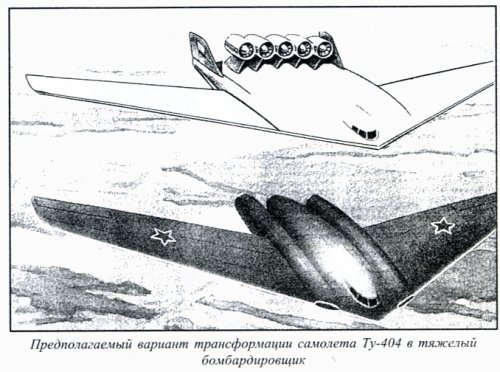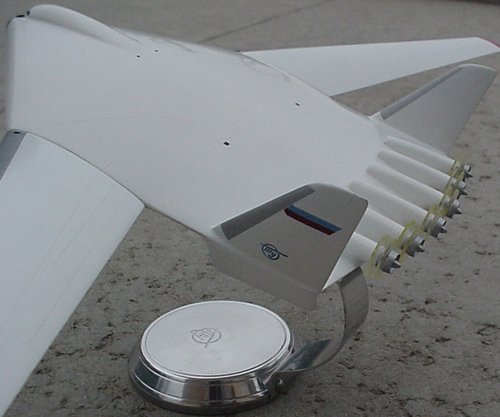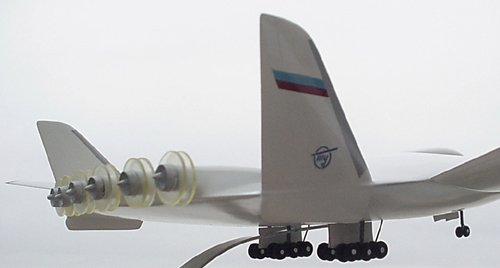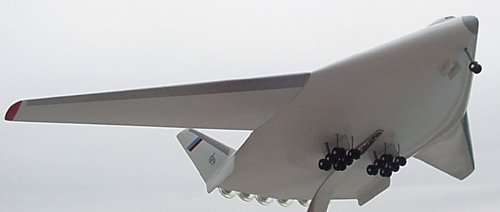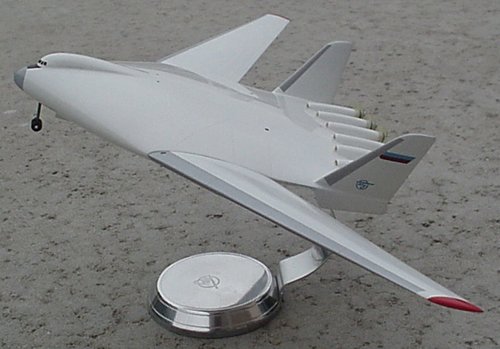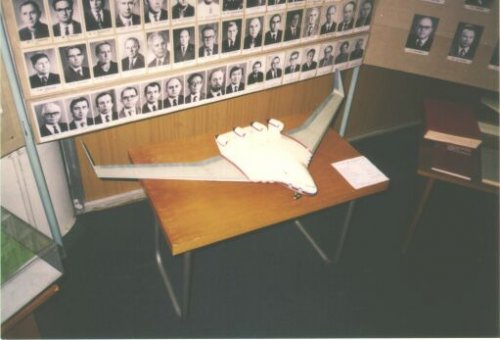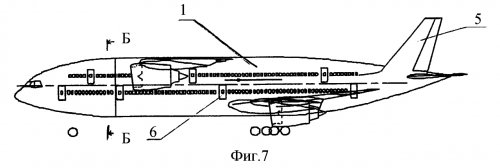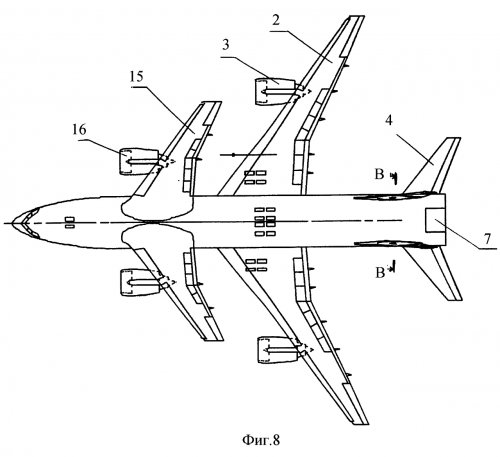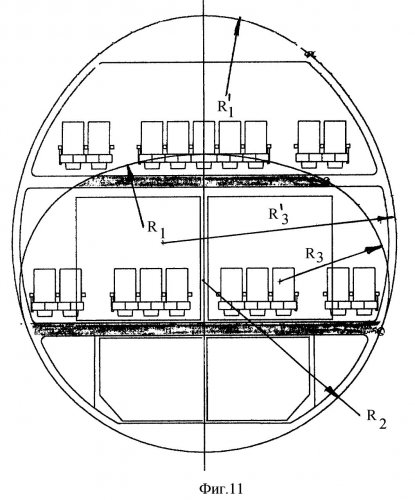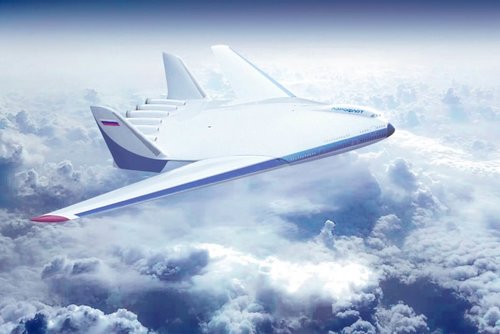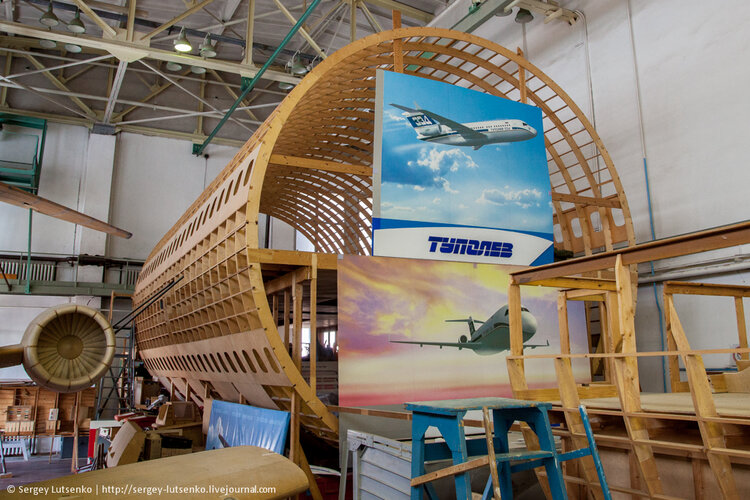You are using an out of date browser. It may not display this or other websites correctly.
You should upgrade or use an alternative browser.
You should upgrade or use an alternative browser.
Tupolev Tu-404
- Joined
- 22 January 2006
- Messages
- 4,213
- Reaction score
- 2,010
Tu-404:
Brassey's World Aircraft & Systems Directory 1996/97, Pg 241
More detailed info + 3 view sketch + model from unknown airshow at "The Osprey Encyclopedia of Russian Aircraft 1875-1995" by Bill Gunston, pg447-448
Active project, under the design leadership of Yuri Vorobjov, for a 600-850 seat giant airliner. Various configurations under study, including huge flying wings
Brassey's World Aircraft & Systems Directory 1996/97, Pg 241
More detailed info + 3 view sketch + model from unknown airshow at "The Osprey Encyclopedia of Russian Aircraft 1875-1995" by Bill Gunston, pg447-448
Work on the Tupolev Tu-404 began in 1991 along with another large passenger aircraft project designated the Tu-304. The Tu-404 was designed to carry more than 1,200 passengers to destinations 12,000 to 13,000 km away. The Tupolev Design Bureau developed several configurations of this heavy passenger transport.
One of the configurations for this aircraft was a blended wing body. The aircraft's powerplant consisted of six pusher turboprop engines each producing 18,000 kg of thrust during take-off and consuming only 0.644 kg/kgf-h of fuel in cruise mode. The engines are located in the tail section of the flying wing fuselage between two large V-shaped vertical stabilizers.
The central fuselage contains six passenger compartments accommodating up to 1,214 passengers. The leading edge of the central fuselage has a sweep of 45 degrees. Two large wings containing fuel tanks have a leading-edge sweep of 35 degrees and are attached to the central fuselage. The wings hold most of the aircraft's fuel.
General Characteristcs
Length (m): 59.7
Wingspan (m): 110
Overall height (m): 110
Wing leading edge sweep: 35°
Passenger capacity: 1,214 in economy class
Number of engines: 6
Engine type: turboprop
Thrust on take-off per engine, kgs: 18,000
Fuel consumption in cruise Mode, kg/kgf h: 0.644
Cruise speed, km/h (M=): 900
Cruise altitude (m): 11,000
Practical range with payload, (km) normal: 13,500 with maximum payload (km): 9,200
Required runway type: Class "A"
Take-off run (m): 3,200
Model (top) of Tupolev Tu-404.
Three view drawing (bottom) of Tupolev Tu-404.
Source: http://www.sergib.agava.ru/russia/tupolev/404/404_e.htm
One of the configurations for this aircraft was a blended wing body. The aircraft's powerplant consisted of six pusher turboprop engines each producing 18,000 kg of thrust during take-off and consuming only 0.644 kg/kgf-h of fuel in cruise mode. The engines are located in the tail section of the flying wing fuselage between two large V-shaped vertical stabilizers.
The central fuselage contains six passenger compartments accommodating up to 1,214 passengers. The leading edge of the central fuselage has a sweep of 45 degrees. Two large wings containing fuel tanks have a leading-edge sweep of 35 degrees and are attached to the central fuselage. The wings hold most of the aircraft's fuel.
General Characteristcs
Length (m): 59.7
Wingspan (m): 110
Overall height (m): 110
Wing leading edge sweep: 35°
Passenger capacity: 1,214 in economy class
Number of engines: 6
Engine type: turboprop
Thrust on take-off per engine, kgs: 18,000
Fuel consumption in cruise Mode, kg/kgf h: 0.644
Cruise speed, km/h (M=): 900
Cruise altitude (m): 11,000
Practical range with payload, (km) normal: 13,500 with maximum payload (km): 9,200
Required runway type: Class "A"
Take-off run (m): 3,200
Model (top) of Tupolev Tu-404.
Three view drawing (bottom) of Tupolev Tu-404.
Source: http://www.sergib.agava.ru/russia/tupolev/404/404_e.htm
Attachments
Another version of the Tu-404 is of a more conventional design: a two-level passenger aircraft capable of transporting 1,200 people to destinations of up to 10,000 km. The lower level of the fuselage is designed as a multi-section cargo compartment for transporting cargo in standard aviation containers. Two sub-variants of this design have been developed: a mixed passenger-cargo aircraft with the enlarge cargo section and a dedicated cargo model.
The massive low-level wing with a leading-edge sweep of 35 degrees and vertical wingtips has massive control surfaces: multi-section leading-edge control surfaces, low-speed control areas, multi-section flaps. Each half of the altitude control surface is made of two sections.
The aircraft is designed to be powered by four Kuznetsov NK-44 or Rolls-Royce "Trent" engines installed on underwing pylons. The aircraft's undercarriage consists of several carts with multiple wheels in each cart. It is retracted into the central fuselage section of the aircraft.
General Characteristics
Length (m): 86.6
Wing Span (m): 77
Overall height( m): 27.3
Wing leading edge sweep: 35°
Max. take-off weight (kg): 605,000
Max. payload (kg): 126,000
Passenger capacity: 1,200
Number of engines: 4
Engine type: Kuznetsov NK-44 turbofan or equivalent
Thrust on take-off per engine (kgs): 40,000
Fuel consumption in cruise Mode kg/kgf h: 0.54
Cruise altitude (m): 11,000
Practical range with payload, (km) normal: 13,500 with maximum payload (km): 9,200
Required runway type: Class "A"
Take-off run (m): 3,200
Source: http://www.sergib.agava.ru/russia/tupolev/404/404_e.htm
The massive low-level wing with a leading-edge sweep of 35 degrees and vertical wingtips has massive control surfaces: multi-section leading-edge control surfaces, low-speed control areas, multi-section flaps. Each half of the altitude control surface is made of two sections.
The aircraft is designed to be powered by four Kuznetsov NK-44 or Rolls-Royce "Trent" engines installed on underwing pylons. The aircraft's undercarriage consists of several carts with multiple wheels in each cart. It is retracted into the central fuselage section of the aircraft.
General Characteristics
Length (m): 86.6
Wing Span (m): 77
Overall height( m): 27.3
Wing leading edge sweep: 35°
Max. take-off weight (kg): 605,000
Max. payload (kg): 126,000
Passenger capacity: 1,200
Number of engines: 4
Engine type: Kuznetsov NK-44 turbofan or equivalent
Thrust on take-off per engine (kgs): 40,000
Fuel consumption in cruise Mode kg/kgf h: 0.54
Cruise altitude (m): 11,000
Practical range with payload, (km) normal: 13,500 with maximum payload (km): 9,200
Required runway type: Class "A"
Take-off run (m): 3,200
Source: http://www.sergib.agava.ru/russia/tupolev/404/404_e.htm
Matej
Multiuniversal creator
frank said:Back in the '90s, wasn't there supposed to be a Soviet flying wing stealth bomber from Tupolev, the Tu-202 or Tu-404 or something?
I think you mean this: http://www.secretprojects.co.uk/forum/index.php/topic,2832.3.html As I understand it, designation Tu-202 is purely hypothetical.
- Joined
- 1 April 2006
- Messages
- 11,394
- Reaction score
- 10,292
Matej said:As I understand it, designation Tu-202 is purely hypothetical.
no
Matej
Multiuniversal creator
Real?
Model of Tupolev Tu-404 from the USSR-Russian Aviation and Space Collectibles web site..
Source: http://www.ussr-airspace.com/index.php?main_page=product_info&cPath=28_39_109&products_id=1311
Source: http://www.ussr-airspace.com/index.php?main_page=product_info&cPath=28_39_109&products_id=1311
Attachments
Attachments
- Joined
- 7 June 2009
- Messages
- 532
- Reaction score
- 159
Triton said:General Characteristcs
Engine type: turboprop
It would be more correct to say "propfan".
Matej said:As I understand it, designation Tu-202 is purely hypothetical.
The Tu-202 project existed, but it had no common with mythical stealth bomber. This designation was used already in early 1970s, for studies of new ASW aircraft. Unfortunately I have no details of them.
Source: "Aviatsiya i Kosmonavtika" magazine, year 2000, No.10, 11 (Cycle of articles "Under "ANT" & "Tu" marks" by Vladimir Rigmant).
- Joined
- 1 April 2006
- Messages
- 11,394
- Reaction score
- 10,292
Very interesting! Thank you flateric! ;D
- Joined
- 9 October 2009
- Messages
- 21,973
- Reaction score
- 13,627
redstar72 said:[The Tu-202 project existed, but it had no common with mythical stealth bomber. This designation was used already in early 1970s, for studies of new ASW aircraft. Unfortunately I have no details of them.
Source: "Aviatsiya i Kosmonavtika" magazine, year 2000, No.10, 11 (Cycle of articles "Under "ANT" & "Tu" marks" by Vladimir Rigmant).
flateric said:bomber and long-range ASW/ABM aircraft as variant, hunting for Ohio and her missiles as option
So, the Tu-404 concept was developed from the Tu-202 concept (Maritime Strike/ASW/ABM) that was under study during the late '80's/ early '90's? With the Tu-202 designation being previously used in the early 1970's for studies into new ASW aircraft designs. Land based ASW platforms I'm assuming?
XP67_Moonbat
ACCESS: Top Secret
- Joined
- 16 January 2008
- Messages
- 2,271
- Reaction score
- 543
Does "Aircraft 202" have any relation to the B-90? Was there even a B-90 project?
- Joined
- 1 April 2006
- Messages
- 11,394
- Reaction score
- 10,292
B-90 was a 'bomber of 90s' program (like I-90 (fighter of 90s) and Sh-90 (attack aircraft of 90s))
program name mentioned, for example, in Oleg Samoilovich memoirs
'202' was a family of ASW aircrafts developed since early _70s_
we shouldn't forget about possibility of re-using designation for totally different projects though
we only can guess if this WT model has anything to do with 202 and its derivatives. you surely won't go for readily visible RCS reduction efforts and put intakes and engines such way if you are building pax carrier (well, after seeing Northrop Environmentally Friendly Troop Carrier I wouldn't be so sure now)






program name mentioned, for example, in Oleg Samoilovich memoirs
'202' was a family of ASW aircrafts developed since early _70s_
we shouldn't forget about possibility of re-using designation for totally different projects though
we only can guess if this WT model has anything to do with 202 and its derivatives. you surely won't go for readily visible RCS reduction efforts and put intakes and engines such way if you are building pax carrier (well, after seeing Northrop Environmentally Friendly Troop Carrier I wouldn't be so sure now)






XP67_Moonbat
ACCESS: Top Secret
- Joined
- 16 January 2008
- Messages
- 2,271
- Reaction score
- 543
Thank you. SSP: Bombers gave just a general description of the project so my curiousity was piqued ("Northrop Environmentally Friendly Troop Carrier" LOL; I like that).
- Joined
- 3 June 2006
- Messages
- 3,094
- Reaction score
- 3,964
Attachments
That link is no longer available, and we, and especially I, have very little idea what the conventional version of the Tu-404 actually would have looked like even with the characteristics we have of the design. So see if you could find any pictures of the conventional design of the Tu-404 if you can. And let me know if you find anything and show it to me. Thank you.Another version of the Tu-404 is of a more conventional design: a two-level passenger aircraft capable of transporting 1,200 people to destinations of up to 10,000 km. The lower level of the fuselage is designed as a multi-section cargo compartment for transporting cargo in standard aviation containers. Two sub-variants of this design have been developed: a mixed passenger-cargo aircraft with the enlarge cargo section and a dedicated cargo model.
The massive low-level wing with a leading-edge sweep of 35 degrees and vertical wingtips has massive control surfaces: multi-section leading-edge control surfaces, low-speed control areas, multi-section flaps. Each half of the altitude control surface is made of two sections.
The aircraft is designed to be powered by four Kuznetsov NK-44 or Rolls-Royce "Trent" engines installed on underwing pylons. The aircraft's undercarriage consists of several carts with multiple wheels in each cart. It is retracted into the central fuselage section of the aircraft.
General Characteristics
Length (m): 86.6
Wing Span (m): 77
Overall height( m): 27.3
Wing leading edge sweep: 35°
Max. take-off weight (kg): 605,000
Max. payload (kg): 126,000
Passenger capacity: 1,200
Number of engines: 4
Engine type: Kuznetsov NK-44 turbofan or equivalent
Thrust on take-off per engine (kgs): 40,000
Fuel consumption in cruise Mode kg/kgf h: 0.54
Cruise altitude (m): 11,000
Practical range with payload, (km) normal: 13,500 with maximum payload (km): 9,200
Required runway type: Class "A"
Take-off run (m): 3,200
Source: http://www.sergib.agava.ru/russia/tupolev/404/404_e.htm
- Joined
- 22 January 2006
- Messages
- 4,213
- Reaction score
- 2,010
Actually, a few different configurations were studied under the Tu-404 project design. The most conventional wasn't very different from Boeing/McDD/Airbus large double decker airliner studies form the 90's.
Other Tu-404 variations were unique and weird in their configurations.
Source: Unflown Wings. Soviet Russian unrealized aircraft projects 1925-2010 by Yefim Gordon and Sergey Komissarov. Ian Allan Publishing
Other Tu-404 variations were unique and weird in their configurations.
Source: Unflown Wings. Soviet Russian unrealized aircraft projects 1925-2010 by Yefim Gordon and Sergey Komissarov. Ian Allan Publishing
- Joined
- 22 January 2006
- Messages
- 4,213
- Reaction score
- 2,010
Found the same drawing identified as Tu-404 studyalternative Tu-304 configuration ('vertical oval tandem wing')
Source: Unflown Wings. Soviet Russian unrealized aircraft projects 1925-2010 by Yefim Gordon and Sergey Komissarov. Ian Allan Publishing Page 93
I was in fact talking about the most conventional one. I just haven't seen any pictures of what that particular design actually looked like. But you're right about it not being very different from other projects from the 90s such as the Boeing NLA, MD-12, and A3XX.Actually, a few different configurations were studied under the Tu-404 project design. The most conventional wasn't very different from Boeing/McDD/Airbus large double decker airliner studies form the 90's.
Other Tu-404 variations were unique and weird in their configurations.
Source: Unflown Wings. Soviet Russian unrealized aircraft projects 1925-2010 by Yefim Gordon and Sergey Komissarov. Ian Allan Publishing
Now we're starting to get somewhere.Early 'tube & wings' 404 fuselage mockup
Resister1976
ACCESS: Confidential
- Joined
- 9 April 2021
- Messages
- 71
- Reaction score
- 46
Tu-404……Error 404-Not Found?Hum……If Tu-404 had served in the Russian Air Force for some years,We could dubbed it "Not Found"!
(0v0)
(0v0)
Rhinocrates
ACCESS: Top Secret
- Joined
- 26 September 2006
- Messages
- 3,053
- Reaction score
- 7,781
They should have reserved that designation for PAK-DA (stealth...).Tu-404……Error 404-Not Found?Hum……If Tu-404 had served in the Russian Air Force for some years,We could dubbed it "Not Found"!
(0v0)
Similar threads
-
-
MDP program - the Mikoyan Product 701
- Started by Tuomasn
- Replies: 30
-
Sukarno stays in power - what would Australia do?
- Started by Dilandu
- Replies: 560
-
Could NATO Frigate 90 have been made to work?
- Started by uk 75
- Replies: 7

